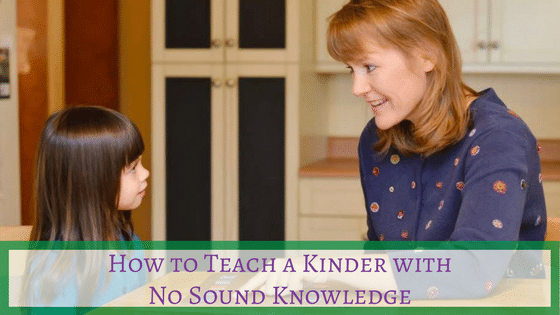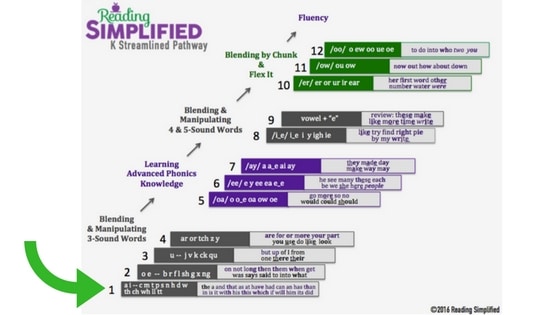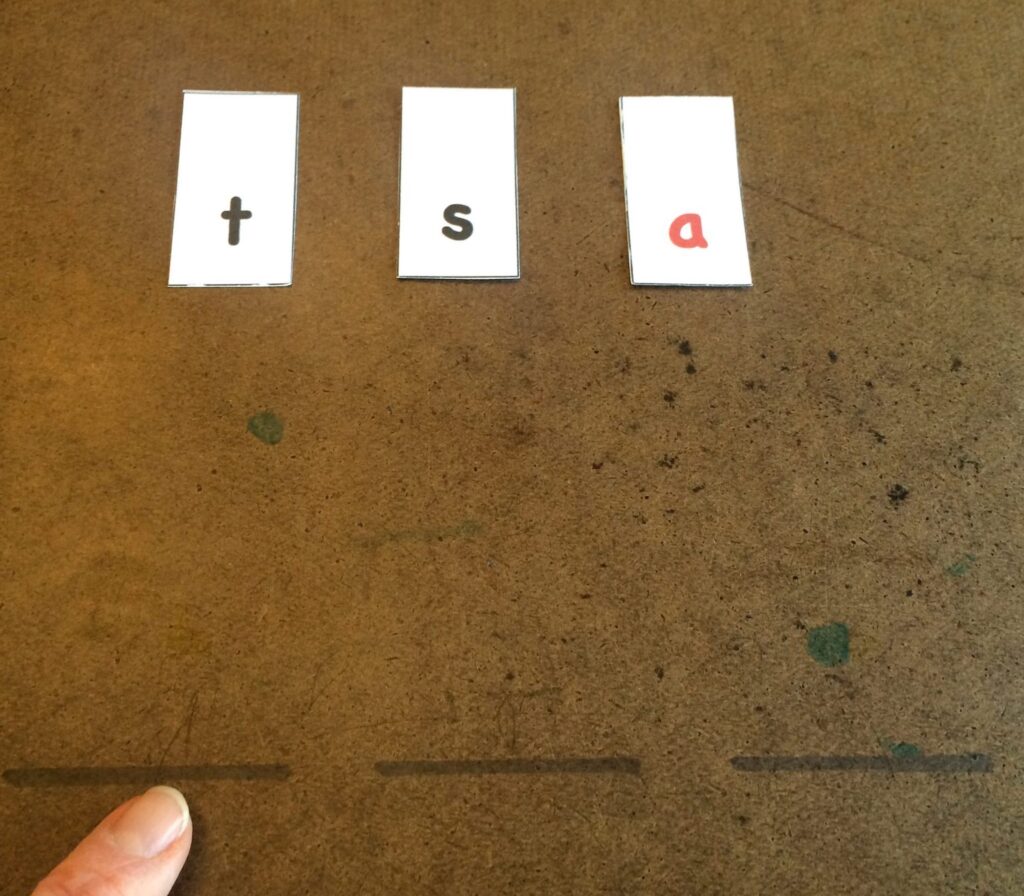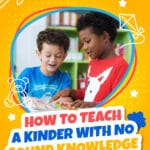
[Flashback Facebook episode on letter-sound correspondences instruction]
Hello! I'm Marnie Ginsberg from Reading Simplified, where we help classroom teachers and homeschool parents streamline their instruction in reading so they can see their students accelerate their achievement.
I am here today with a short little answer to one of our reader’s questions about letter-sound correspondences instruction.
Many of you have been following us recently as we've gone through a 5 Day Challenge learning about the activity Switch It. Just one activity, Switch It, can have some really powerful impact on your students. It helps with:
- the concept of the alphabetic principle;
- letter sound knowledge;
- particularly short vowels or the consonants;
- phonemic segmentation and
- phonemic manipulation.
And it really lays the groundwork for strong decoding and excellent spelling, so Switch It encompasses a lot.
We got a question today from a kindergarten teacher, and she was excited to hear about Switch It, but also has kids who come in not knowing a lot of letter-sound knowledge so she wasn't sure when it was applicable. I wanted to answer her question not only to her, but also to you guys.
This is an answer to this kindergarten teacher’s question about her instruction and Switch It.
A Kindergarten Teacher's Question about Letter-Sound Instruction
She writes to me –
“Our four and five year old kinder students, full-day, first year of formal schooling, come to school with little or no sound knowledge. There is a great deal of sound letter development to do at the beginning of the year.”
“My question is, how early would you introduce the Switch It strategy? I assume the children need some sound knowledge, maybe a term before using this technique. I'm very keen to try something new with my Kinders this year and would appreciate your input.”
I'm really glad for the question and it is a super question…
Because we were witnessing in the most recent challenge–for those of you who joined us through our January challenge–we witnessed a child who already knew all of her consonants, all of her consonant digraphs for the most part, and she was pretty solid with her short vowels, just a little rusty on two.
When we moved her up, it probably seemed natural that she was doing an activity like Switch It, where there were a lot of letter sounds on the board and she was moving letter sounds like from “held” to “help” and that makes sense because she knows some letter sounds.
But on the other end of the continuum, when you have a beginner or a real struggler who doesn't know the letter sounds, what do you do?
Mainstream Kindergarten Instruction of Letter-Sound Correspondences
Well, what I just first want to point out is what typically happens. The reason I'm saying Reading Simplified techniques save you time is that traditional practice is really super inefficient.
Let's look at this very famous scope and sequence example from basal, a series that is very very well known and very frequently used.
You can, perhaps you can see that down here for one week they're going to focus on, near the beginning of the year, they're going to focus on the /mmm/ sound, the letter “m,” so that's the sound that they focus on for one week.
And then, guess what?
The next week, they're going to teach short “a,” /a/; then the third week they're going to teach the sound /s/; the fourth week, teach the sound P.
So we're at the fourth week of school, a month has gone by, and a kindergarten child will have been exposed to four letter sounds.
Then this continues, week five is the letter “t” and week six is review, and then there's another review at week twelve…Every week just adding in one new letter sound and by week 16, these kindergarten students would have only been exposed to explicitly 14 letter sounds.
A Streamlined Alternative to Letter of the Week!
And I propose, and have experienced this innumerable times, that there is a lot shorter way to go about this, and so I've designed this scope and sequence that kind of turns these Excel spreadsheets that go on and on and on to 50 to 60 to 70 pages on its head.
Instead of thinking about doing one sound per week, I encourage you to do multiple sounds in one week in the context of a real word.
Thus, at the beginning of this Streamlined Pathway, these kids would be exposed to a lot of short vowels and consonants, all at once. Maybe A, S, M, P, T and O.
In the first week, they would build “mop,” and they would build “map,” and they would build “sat” and they would build other words with those–that handful of letter sounds. We can take the back and forth of Switch It, the letter sound emphasis, the phonemic segmenting emphasis, and just take out one component–the switching part–and we will have Build It.
On your board, you would have, let me show you an example, on your board you would have, up here, just three letter sounds to choose from. So if we wanted our student to build the word “map,” they would have scrambled up here M, A and P. That would be it. And so you would ask them to build the word “map.”
What do you hear at the beginning of /mmm/ “map?”
And they would pick the right sound, but if they didn't know it, that's fine, first you say, “well what sound do you hear when I say /mmm/ ‘map?’” You get them to acknowledge the sound, and then they would pick the right letter sound or the right symbol to go with it, and you go through the word that way, left to right.
And so that is basically very similar to Switch It, but you take out some of the challenge of the manipulating and we call it Build It. And they can learn those letter sounds in the context of Build It, in the context of real words that way. So let me just share this to the group that we have created for the 5 Day Challenge, and then I'll continue explaining why that is a more efficient way.
Instead of thinking about doing one letter sound on week one and another letter sound on week two and another letter sound on week three, you can start the very first week, giving them, say, three or four letter sounds, and they play with those and make as many words as they can.
Now there would be a lot of teacher instruction involved and I would encourage it to happen in small groups, but you could also do it as a whole group.
And so what happens with typical Reading Simplified kids, is that they learn all the consonants and the short vowels in a matter of two weeks, three weeks, four weeks, five weeks, sometimes six weeks if they're having trouble. Typically I am moving them well out of the short vowel level after three or four weeks of instruction, even those who are beginners.
So that is an answer to, a partial answer, to this teacher's question.
She was wondering, “How do you do something like Switch It with kids who don't know the letter sounds?”
Well, you just reduce the number of letter sounds that you're going to expose them to, and you take out the manipulating part, because that's maybe too much for them right now, but just have them build one letter sound at a time, and so they would, or one word at a time, so they would build “map” and you could take those letter sounds away and the next one they build would be “sat” and then take those away, next one they would build would be “mop”.
And you don't always pick a rhyming word like “sat,” “mat,” “fat,” because that can tune their brain out and they won't pay attention to how each sound lines up based on sounds.
That is a short answer to her question, and Build It is really the first activity that I recommend in the Reading Simplified system for those kids who don't know the letter sounds or who don't really get segmenting at all.
But you can very quickly fade Build It out and add in Switch It, so as soon as your kids know four or five letter sounds, they can, they then add future letter sounds by actually doing Switch It.
One day, they just are given a board with letter sounds up here that they haven't seen before, maybe just one or maybe two, but they can deduce what the right thing is when they notice, hmm, I need to switch “sat” to “fat,” well they know that there's going to be a /f/ there, they may not know which picture or spelling is /f/, but they know that there's one that doesn't match.
Thus they figure it out and they gradually fold in the knowledge of the letter sounds much more quickly this way with Switch It.
So in the context of real words, in the context of this visual cue, in the context of hearing the sounds, all those things together integrated, create an environment where your student can learn a lot more quickly the letter sounds, because it makes a little bit more sense to him, what these letter sounds are.
If they come to you in kindergarten and they don't know any letter sounds, they probably haven't been exposed to a lot of literacy instruction, and so things in isolation can be confusing and it may not make any sense, so that is how Build It can quickly establish your students’ letter sound knowledge.
That's a little answer to our question from the kindergarten teacher, thank you for writing in your question. I get a lot of those and I'd love to hear some more. We'll be doing more of these little Q&A’s where you can get little quick answers to what your actual concerns are, so I look forward to sharing more with you, so please let me know what kinds of questions or comments or issues you encounter.
An Invitation to the Reading Simplified Academy
And I also want you to know today, Tuesday, is the last day for our final Early Bird Pricing. We've had one wave in November and now we're having a second wave of Early Bird Pricing it, but it ends tonight, for our Reading Simplified Academy. [This discount has unfortunately expired.]
And that is a membership where I teach you all these strategies like Switch It, Build It, Read it, Sort It, and how to use them together in a system that works for beginners or strugglers from pre-k to sixth grade and I've even worked with middle school, high school and even adults. It creates a system that's streamlined for you, and it provides you with all the resources that you need so that you don't have to work a lot.
I was just speaking with a member to our Reading Simplified Academy and she has been a public school teacher but also a private tutor and she said, it used to be that to prep for a tutoring session for an hour, she would take an hour to prep. Now she's just printing out some materials and she's ready to go because the activities are few but powerful and the materials are there at the ready.
And it's not a lot of worksheets in the sense that there's a lot of busy work–there are activities and dynamic things like Switch It, but when you need something for the student to read or to write, that is provided for you in some really nice looking material.
So if you've been thinking about the Reading Simplified Academy, I wanted you to know that tonight is the end of that final Early Bird Pricing, so the price tomorrow will go up over 11%, and also the Bonus is the FREE recap page to the Level Up Your Reader’s Achievement In The Next 5 Days. [Offer expired.]
It's a whole website with over two hours of professional development videos and a mini e-Book in a PDF e-book of all of our e-mail trainings to go along with that. So if you missed anything about Switch It, that's a great recap page, it's free if you become a member of the Reading Simplified Academy, and it, even if you were there all along and you caught Switch It but you want to share it with your colleagues, it's a great resource to share with them.
So it's free today and there's a link above or below, but after today it will cost $97, but if you join the Reading Simplified Academy, it will be free for you.
And then I wanted to announce another Bonus, just for those of you who are catching this now, there are not many people that know about this, but if you get a friend to sign up and so you can walk this path together and that's a much more powerful way to learn.
You get a friend to sign up, you can get the next two months free yourself.
The Reading Simplified Academy is often, it doesn't have to be, but it's often a monthly membership, so if you take that route and you bring in a friend who also joins, I would be delighted to give you the next two months for free.
Please keep that in mind because I do believe that teachers are way too isolated and then if you can work together with a colleague, that you will get a lot more benefit from it. And I will also be pleased that more people are encountering this system.
If you have any questions or comments please send them in via e-mail or through any of the Facebook pages that we have, this Reading Simplified page or the private Facebook group Level Up Your Reader’s Achievement In The Next 5 Days, and I'll be answering them. I'll be sending out questions and Q & A’s like this a lot more in the future so you can get answers to your questions. Let me know what you want to know! Thanks!






I have been implementing your strategy and noticed that students are becoming better at blending during switch it.
That’s great news Laura! Yes, it’s cheesy but I say Switch It and Read It are as good together as peanut butter and jelly. 😉